The Right Connection: Learn the Types of Steel Beams and How They Work
There’s a solution for any construction job, so understanding the types of steel beams is important. While many of these steel beams look similar, they can greatly enhance your construction project. So before moving forward with any construction planning, you need to learn the types and how they work.
Bolted Framed Connections
In this kind of steel beam connection, the beams are linked directly to a supporting element, such as a column or another girder. Here, the steel frame is bolted together. The bolts are not one-size-fits-all, though. It is necessary to consider the kind of steel, the size, and even the strength of the steel to determine which bolt will be best for the project.
One of the main benefits of a bolted frame connection is it can be easily and quickly installed. Once secured, the bolts are fastened on, and the construction can continue.
Bolted Seated Connection
Bolted seated connections are separated into two main categories. One is an unstiffened bolt seat connection, and the other is a stiffened bolted seat connection. With the bolted seated connection, the connectors are placed on top and bottom of the beam and fastened to the vertical column. The connector, or cleat, will fix to the top of the beam and the side of the column. With an unstiffened bolt seat, the difference is with the seat angle installed under the beam. The seat is similar to the top cleat connector for the beam.
On the other hand, the seat angle is far larger with the unstiffened bolted connection. Additionally, there is extra support for the seat angle. Due to this, when larger amounts of weight are at stake, a stiffened bolted seat connection is generally recommended.
Bolted connections, whether in the form of a frame or seated connection, are desirable in that both can be quickly set up and installed without downtown. For other connections, it can require additional work and possibly even a specialist on hand to perform the connection.
Welded Framed Connection
Instead of a bolted framed connection, where the bolted installation takes place on the side of the beam where it connects to the column, this is replaced by welding the beam and the column together. Whenever dealing with a welded connection, it is important to know the allowed weight and volume for the beam and what it can hold. In many cases, a welded frame may simply not be a viable option when it comes to larger amounts of weight. However, for lighter jobs, where a more seamless look is desired (possibly for exposed beams), the welded framed connection may be the option to consider.
Welded Seat Connection
Again, like the welded framed connection, the welded seat connection secures the beam to a column through a weld on the top of the beam and the bottom (the seat). Both a stiffened and a stiffened seat weld are possible. Usually, an unstiffened weld is used for smaller loads, while the stiffened weld is used for larger loads.
In some instances, it may be possible to use a combination of a weld connection and a bolt connection. This is specifically the case many times with a seated connection. Following the welding procedure, the seated bolt connection can be installed. This way, it provides additional support, making it nearly impossible for the girders to be dismantled. The combination of weld and bolt secures everything in place for any foreseeable future.
Specialized Connections
There will be times when one of the listed traditional steel beam connections simply is not possible. This might be due to physical constraints on where the beams are installed, or it might be due to the weight of particular beams. In these instances, a specialized connection will need to be forged. The connection might be half-frame, half seated, or partial welding with partial bolting. There might be specialized patterns for the bolted connections, and some of the seated connections might be longer to make up for the lack of securing the beam elsewhere. There is no shortage of specialized connections. Typically, you won’t need to look into these one-off connections within your construction, but it might be necessary from time to time, depending on the job. Before beginning the fabrication process, you will likely know what kind of beam connection is right for you.
End Plate
The endplate connection is accomplished through more welding. However, the welding required for an end plate connection is far more elaborate than what would be necessary for a regular welded seat or frame connection.
The true benefit of an endplate connection is it essentially erases the visual appearance of any kind of connection. There is no seat or frame bolted to the column or the rest of the girder. It has a flush visual appearance that can be especially desirable. There are also several end plate connections, ranging from rigid to flexible.
It is important to note that this kind of steel beam connection is not used for taller constructions. It brings mostly visual appeal for a project that might want an industrial, minimal look yet maintain a smaller construction size.
Help With Your Steel Beam Needs
This basic information should give you an initial understanding of steel beams and what the beams can do for your construction project. However, if you still have questions about what these beams can do for your job, or if you’re interested in a product quote, now is the time to contact the expert customer service staff at C-Beams. Whether you’re ready to start work or you want to have insider information on which particular steel beam will provide you with the most desirable results, the team at C-Beam is here for you.






